Picture a golden sea of black oil sunflowers swaying in your backyard, their cheerful faces soaking up the sun while bees buzz and birds chirp in delight. 🌼 These iconic plants aren’t just a feast for the eyes—they’re a gift to your garden, wildlife, and even your pantry! Whether you’re a newbie gardener or a seasoned green thumb, mastering black oil sunflower planting is your ticket to vibrant blooms and bountiful seeds. In this comprehensive guide, we’ll walk you through every step—from choosing seeds to harvesting nutritious black oil sunflower seeds—backed by horticultural expertise and practical tips. Ready to grow a stunning sunflower patch? Let’s dig in! 🌱
1. Why Grow Black Oil Sunflowers? 🌻
Black oil sunflowers are more than just pretty flowers; they’re a powerhouse for your garden and beyond. Their versatility makes them a favorite among gardeners, wildlife enthusiasts, and homesteaders. Here’s why they deserve a spot in your yard.
1.1 Benefits for Your Garden and Beyond 🌿
- Aesthetic Appeal: Black oil sunflowers bring bold, sunny vibes with their bright yellow petals and dark centers, instantly elevating any garden’s charm.
- Wildlife Magnet: Their nectar-rich blooms attract pollinators like bees and butterflies, boosting biodiversity. 🐝🦋 Later, birds flock to feast on the seeds, creating a lively ecosystem.
- Seed Production: These sunflowers are prized for their small, oil-rich seeds, perfect for bird feed, human snacks, or even pressing into cooking oil.
- Soil Health: Their deep taproots break up compacted soil, improve drainage, and reduce erosion, leaving your garden healthier.
1.2 Black Oil Sunflowers vs. Other Varieties 🌼
Unlike ornamental sunflowers bred for giant blooms or confectionery types with large, striped seeds, black oil sunflowers are compact and prolific. Their smaller flowers (4–8 inches) pack a punch with high seed yields and oil content (up to 40%). Varieties like ‘Mammoth Russian’ or ‘Perdovik’ are ideal for sustainable gardening, offering resilience and productivity. Expert Insight: Horticulturists favor black oil sunflowers for their low-maintenance growth and eco-friendly benefits, making them a staple in regenerative gardens.
2. Understanding Black Oil Sunflowers 🌱
To grow thriving sunflowers, it helps to know their biology and needs. Let’s break down the essentials.
2.1 Botanical Overview 🌿
- Scientific Name: Helianthus annuus (black oil varieties).
- Growth Habits: These annuals grow 3–6 feet tall, with single-stem or branching forms, depending on the cultivar.
- Key Features: Dark, oil-rich seeds and sturdy stalks make them ideal for seed production. Their heliotropic heads track the sun, maximizing photosynthesis.
2.2 Ideal Growing Conditions ☀️
Black oil sunflowers are hardy but thrive under specific conditions:
- Sunlight: Full sun (6–8 hours daily) is non-negotiable for robust growth.
- Soil: Well-draining, loamy soil with a pH of 6.0–7.5. Test your soil with a kit for best results.
- Climate: Adaptable to USDA zones 2–11, they tolerate mild frost after germination.
- Pro Tip: Slightly acidic soil enhances nutrient uptake, so aim for a pH around 6.5.
3. Step-by-Step Guide to Black Oil Sunflower Planting 🌻
Ready to plant? Follow these expert-backed steps for a flourishing sunflower patch.
3.1 When to Plant ⏰
Timing is critical for black oil sunflower planting. Sow seeds in spring after the last frost, when soil temperatures reach 50°F (10°C) or higher. In colder climates (e.g., USDA Zone 4), wait until mid-May. In warmer zones (e.g., Zone 9), plant as early as March. Check your local frost dates for precision. Example: In Zone 7, aim for mid-April to early May for optimal germination.
3.2 Choosing the Right Seeds 🌾
Select high-quality, non-GMO black oil sunflower seeds from reputable suppliers like Burpee or Johnny’s Selected Seeds. Popular varieties include:
- ‘Mammoth Russian’: Tall, single-headed, with large seed yields.
- ‘Perdovik’: High oil content, ideal for bird feed.
- ‘Black Beauty’: Compact, perfect for smaller gardens.
Look for organic or heirloom options to ensure purity and sustainability.
3.3 Preparing Your Garden Bed 🛠️
A well-prepared bed sets the stage for success:
- Clear weeds, rocks, and debris to reduce competition.
- Loosen soil to 12–18 inches deep to accommodate deep roots.
- Mix in 2–3 inches of compost or aged manure for nutrient-rich soil.
- Pro Tip: Avoid synthetic fertilizers at planting; they can burn delicate seedlings.
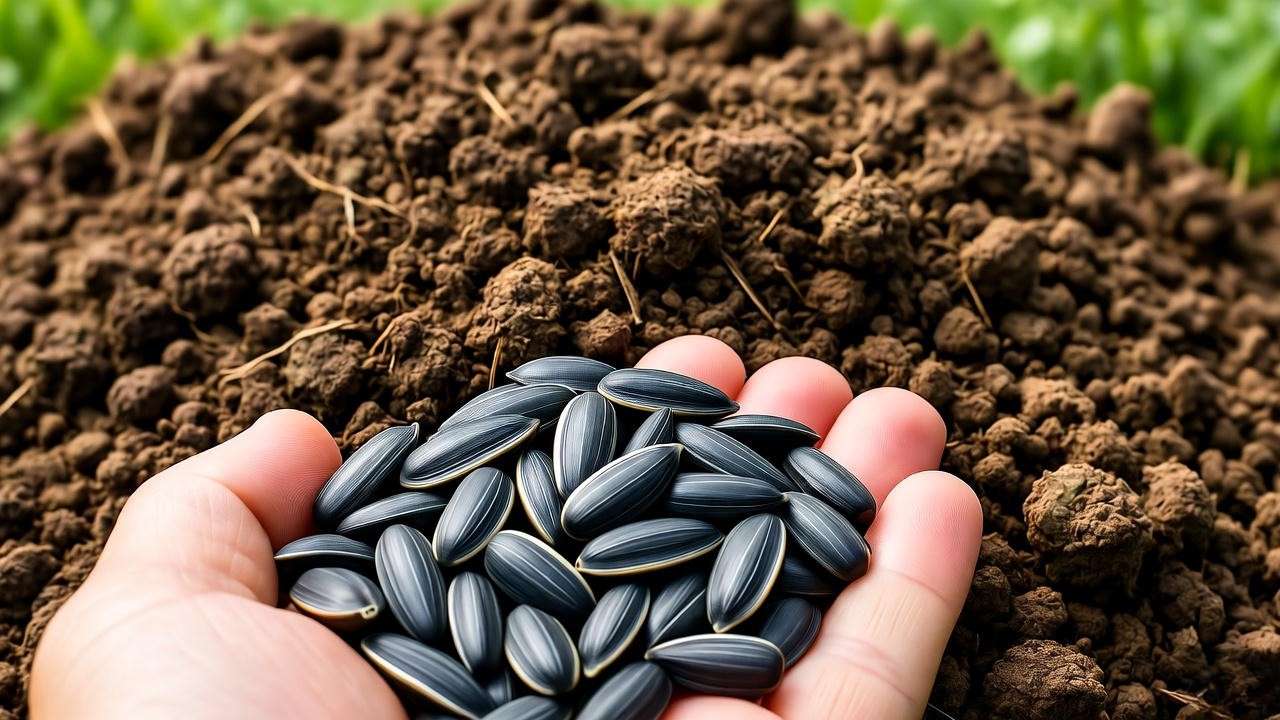
3.4 Planting Techniques 🌱
- Sow seeds 1 inch deep and 6–12 inches apart, depending on variety (closer for compact plants, wider for giants).
- Plant in rows for easy maintenance or clusters for a natural look.
- Water gently but thoroughly after planting to kickstart germination (7–10 days).
- Spacing Tip: For branching varieties, allow 18–24 inches between plants to prevent overcrowding.
4. Caring for Black Oil Sunflowers 🌼
Proper care ensures your sunflowers reach their full potential. Here’s how to keep them thriving.
4.1 Watering Needs 💧
- Water deeply but infrequently, providing about 1 inch of water per week (adjust for rainfall).
- Young plants need consistent moisture; mature plants are more drought-tolerant.
- Avoid overhead watering to prevent fungal diseases like powdery mildew.
- Expert Tip: Use a soaker hose for efficient, root-level hydration.
4.2 Fertilizing for Success 🌿
- Apply a balanced fertilizer (10-10-10 NPK) at planting and again when plants reach 2 feet tall.
- Organic alternatives: Compost tea or fish emulsion for eco-friendly nutrition.
- Warning: Excess nitrogen can cause tall, weak stems that flop over.
4.3 Supporting Tall Plants 🌳
Sunflowers over 4 feet may need support to withstand wind:
- Use bamboo stakes or metal cages, securing stems loosely with garden twine.
- DIY idea: Repurpose old tomato cages for cost-effective support.
- Expert Insight: Staking not only prevents breakage but also boosts seed production by keeping plants upright.
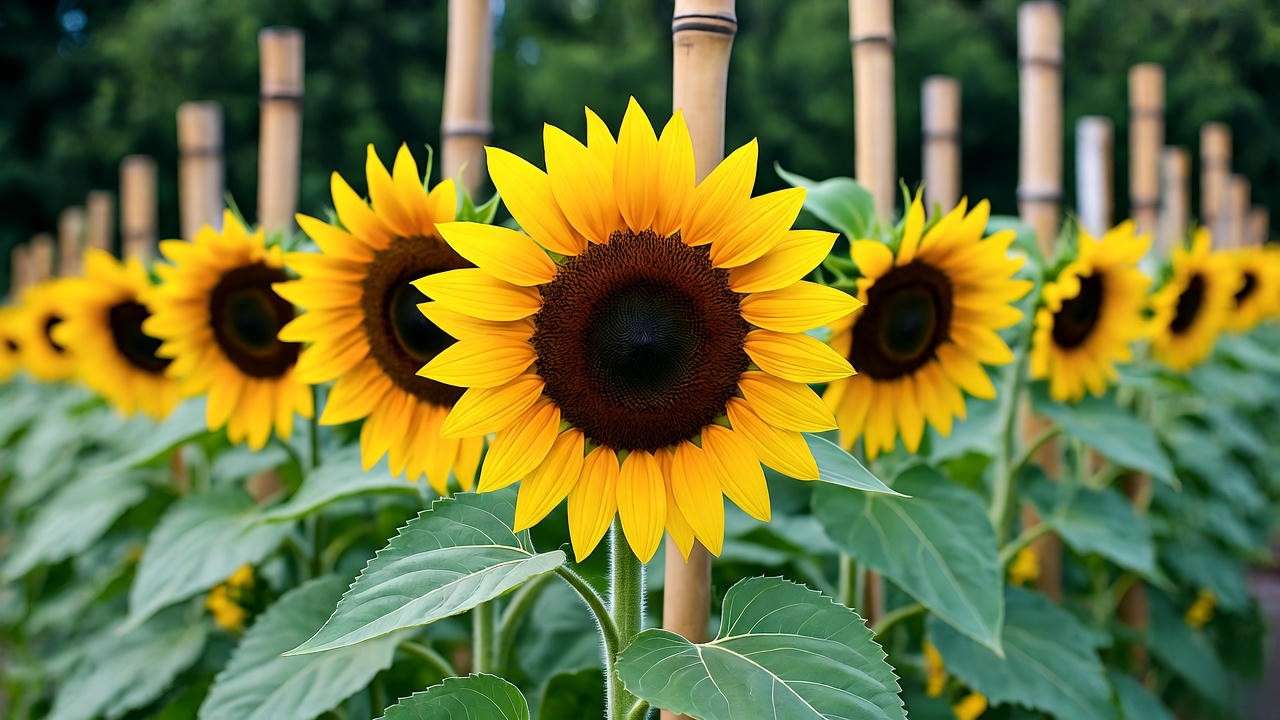
4.4 Pest and Disease Management 🐞
- Common Pests: Aphids, sunflower moths, and birds. Use neem oil or insecticidal soap for aphids; hand-pick moths or use row covers.
- Bird Protection: Cover maturing heads with breathable netting or burlap bags.
- Diseases: Downy mildew and rust thrive in humid conditions. Ensure good air circulation and avoid overwatering.
- Organic Solution: Plant marigolds nearby to repel pests naturally.
5. Harvesting Black Oil Sunflowers 🌾
The reward of your efforts? A bountiful seed harvest! Here’s how to do it right.
5.1 When and How to Harvest Seeds ⛏️
- Timing: Harvest when flower heads droop, petals dry, and the back of the head turns brown (30–45 days after blooming).
- Method: Cut heads with 6 inches of stem, hang indoors in a dry, well-ventilated area for 1–2 weeks, then rub seeds free.
- Storage: Store seeds in airtight containers in a cool, dry place to maintain viability.
- Pro Tip: Wear gloves to avoid sticky sap during harvest.
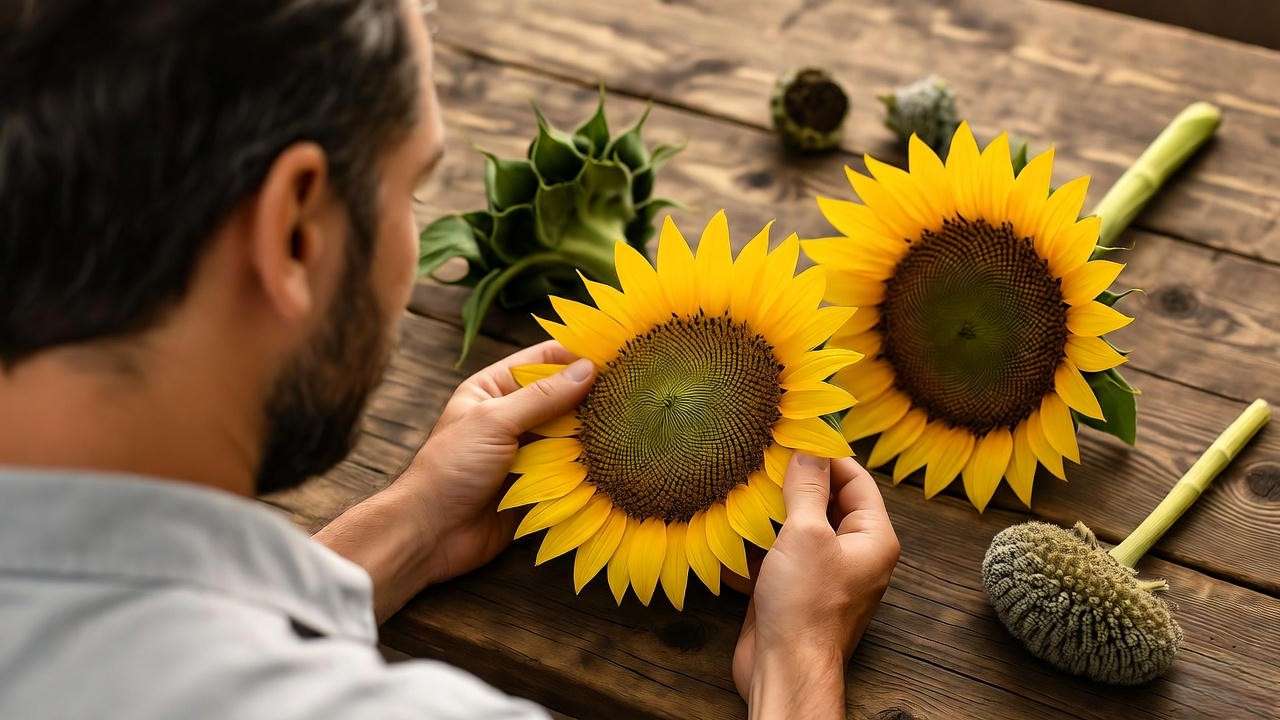
5.2 Uses for Black Oil Sunflower Seeds 🥜
- Bird Feed: Attract cardinals, finches, and chickadees with nutrient-packed seeds.
- Human Consumption: Roast with salt for a healthy snack or press for homemade sunflower oil.
- Replanting: Save 10–20% of seeds for next season’s crop, ensuring genetic diversity.
6. Troubleshooting Common Issues 🔧
Even with the best care, black oil sunflowers can face challenges. Here’s how to diagnose and fix common problems to keep your plants thriving.
6.1 Why Aren’t My Sunflowers Blooming? 🌻
If your sunflowers aren’t producing those iconic blooms, consider these culprits:
- Insufficient Sunlight: Sunflowers need 6–8 hours of direct sun daily. Relocate to a sunnier spot or prune overhanging branches.
- Poor Soil Quality: Nutrient-deficient or compacted soil stunts growth. Test soil and amend with compost or a balanced fertilizer.
- Improper Planting Depth: Seeds planted too deep (>1 inch) struggle to germinate. Replant at the correct depth if needed.
- Solution: Ensure optimal conditions and monitor for pests that may damage buds before they open.
6.2 Dealing with Drooping or Weak Stems 😔
Tall sunflowers can flop over, especially in windy areas:
- Overwatering: Soggy soil weakens roots. Water only when the top inch of soil is dry.
- Nutrient Imbalance: Excess nitrogen promotes leafy growth over sturdy stems. Switch to a low-nitrogen fertilizer (e.g., 5-10-10).
- Lack of Support: Unstaked plants are prone to bending. Add stakes or cages early in the growth cycle.
- Fix: Reduce watering, adjust fertilization, and stake plants to restore stability.
6.3 Preventing Seed Loss to Birds 🐦
Birds love black oil sunflower seeds, but you can protect your harvest:
- Cover flower heads with breathable netting or burlap bags as seeds mature.
- Plant decoy crops like millet to distract birds from your sunflowers.
- Companion plant with thorny or dense plants (e.g., roses) to deter wildlife.
- Pro Tip: Harvest slightly early if bird activity is high, then dry heads indoors.
7. Advanced Tips for Maximizing Growth 🚀
Ready to take your black oil sunflower planting to the next level? These expert strategies will boost your yields and garden’s vibrancy.
7.1 Companion Planting for Sunflowers 🌼
Companion planting enhances growth and protects your sunflowers:
- Pair with pole beans or squash to create a “Three Sisters” guild, where sunflowers provide support for climbing plants.
- Plant marigolds or nasturtiums nearby to repel aphids and attract beneficial insects like ladybugs.
- Avoid planting near potatoes, which compete for nutrients and may stunt sunflower growth.
- Expert Insight: Companion planting not only reduces pests but also improves soil health through diverse root systems.
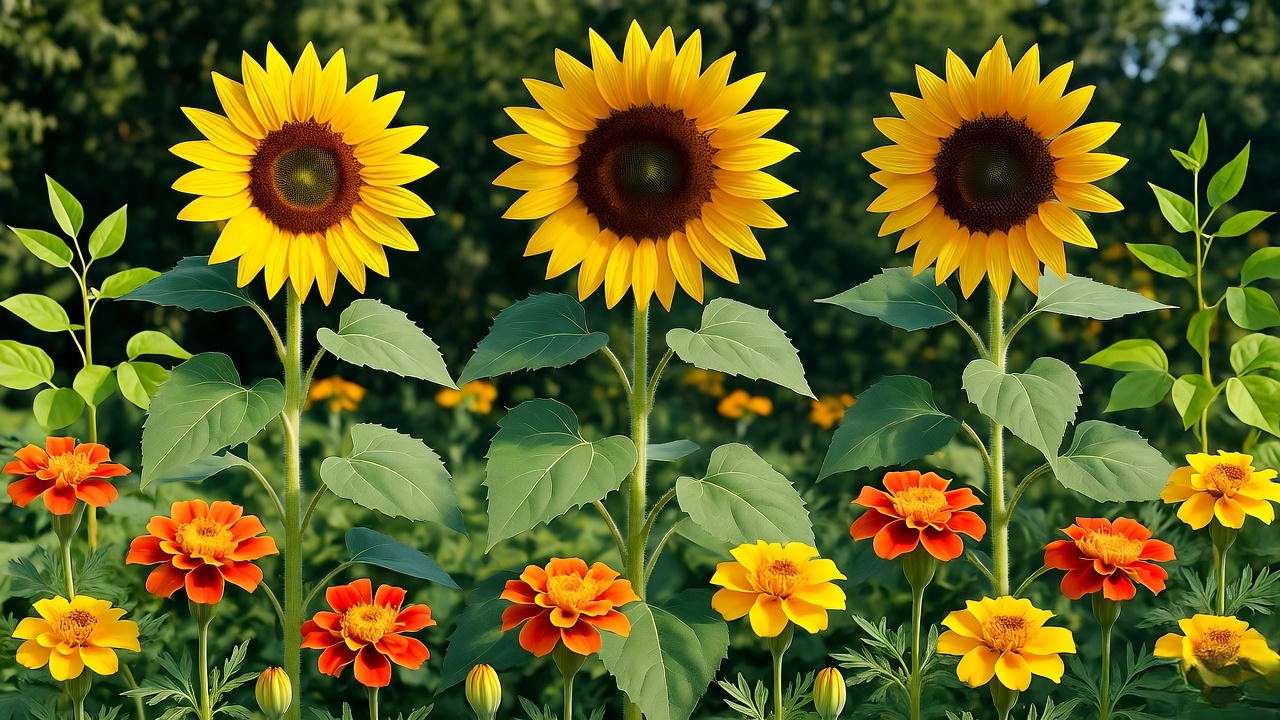
7.2 Succession Planting for Continuous Blooms 🌸
For a summer-long display of blooms:
- Sow seeds every 2–3 weeks from spring to early summer, ensuring a staggered harvest.
- Mix early-blooming (‘Perdovik’) and late-blooming (‘Mammoth Russian’) varieties for extended flowering.
- Example: In a small garden, plant three batches of 10 plants each, two weeks apart, for continuous color and seeds.
7.3 Eco-Friendly Gardening Practices 🌍
Sustainability enhances your garden’s health and reduces environmental impact:
- Mulch: Apply 2–3 inches of organic mulch (e.g., straw or wood chips) to retain moisture and suppress weeds.
- Rainwater Harvesting: Collect rainwater in barrels for eco-friendly irrigation, reducing water waste.
- Compost: Recycle garden waste into compost to enrich soil naturally.
- Pro Tip: Mulching also regulates soil temperature, keeping roots cool during hot summer days.
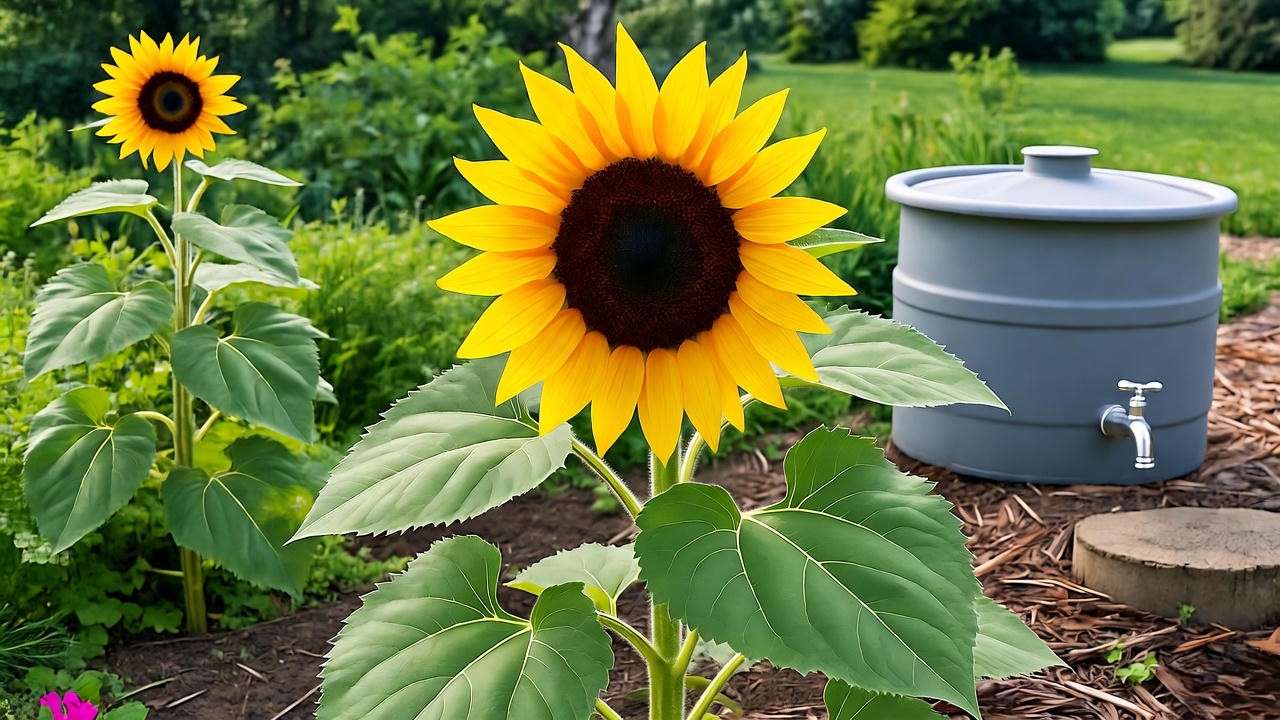
8. FAQs About Black Oil Sunflower Planting ❓
Here are answers to common questions gardeners ask about growing black oil sunflowers, based on real-world experience and horticultural expertise.
- How long do black oil sunflowers take to grow?
From planting to seed harvest, expect 70–100 days, depending on variety and climate. Blooms typically appear 50–60 days after planting. - Can I grow black oil sunflowers in containers?
Yes! Use large pots (5 gallons or more) with drainage holes. Choose compact varieties like ‘Black Beauty’ and ensure full sun exposure. - Are black oil sunflowers invasive?
No, as annuals, they don’t spread aggressively. Remove spent plants to prevent self-seeding in unwanted areas. - What’s the best way to attract pollinators?
Plant sunflowers in clusters to create a pollinator hotspot. Avoid pesticides and include nectar-rich companions like lavender or bee balm. - How do I save seeds for next season?
Select healthy, fully mature seeds, dry them thoroughly, and store in a cool, dry place. Label with variety and date for organization. - Expert Note: Mixing early- and late-blooming varieties extends pollinator activity, supporting local ecosystems throughout the season.
9. Conclusion: Grow Your Best Sunflowers Yet! 🌞
Black oil sunflowers are a joy to grow, offering vibrant blooms, wildlife benefits, and nutritious seeds. By following this guide—covering planting, care, harvesting, and advanced tips—you’re equipped to cultivate a thriving sunflower patch, whether you’re a beginner or a seasoned gardener. Start with quality seeds, provide ample sun and well-drained soil, and protect your plants from pests and wind. The result? A garden bursting with life and a harvest to share with birds, friends, or your kitchen table. 🌻
Ready to grow? Plant your black oil sunflowers today and share your progress in the comments below! 📸 Have questions or tips to share? We’d love to hear from you. Let’s make this season your best sunflower harvest yet!













